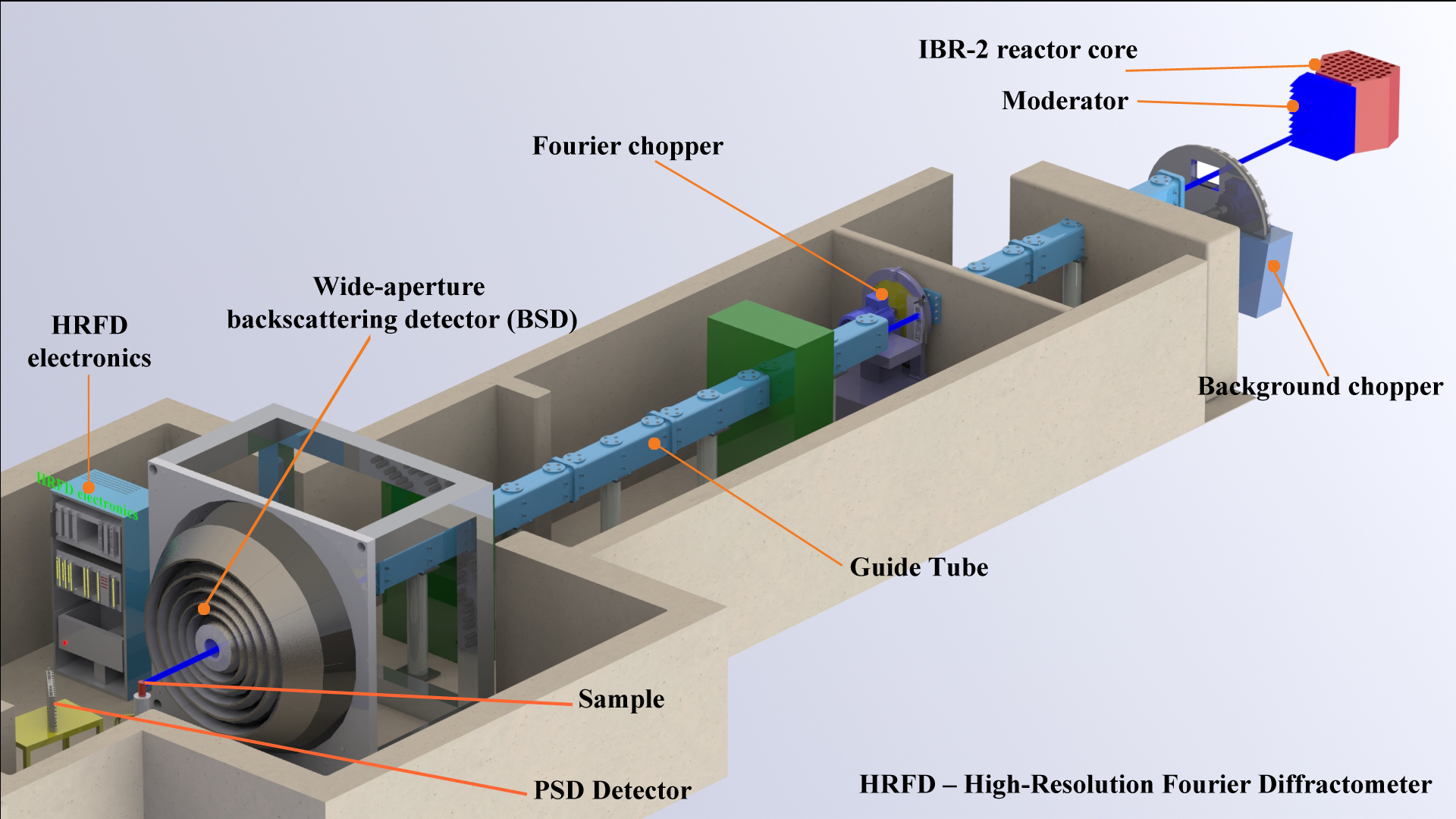High Resolution Fourier Diffractometer
Responsible for the facility
Sumnikov Sergey
tel.: +7 (49621) 62-132
e-mail: This email address is being protected from spambots. You need JavaScript enabled to view it.
Main research areas
1. Precision analysis of the structure of polycrystalline samples;
2. Analysis of the shape of monocrystal diffraction peaks with Δd/d ≈ 0.001;
3. Microstructure analysis of crystalline materials;
4. Analysis of magnetic ordering in polycrystals.
Facility layout
Main view of facility
Sample environment
Description of HRFD
The High Resolution Fourier Diffractometer is positioned on beamline 5 of the IBR-2. Its primary function is a precision analysis of the structure of polycrystalline samples; however, the tool can also be used to investigate the structure of monocrystals. Due to its high resolution, the diffractometer allows one to study the microscopic parameters of crystalline materials, such as microdeformations, the shape and size of coherently scattering areas (crystallites).
Like other diffraction devices, HRFD operates in the time-of-flight mode. Diffraction patterns are based on an analysis of the energy of scattered neutrons and the neutron energy, in turn, is calculated from the time of the neutron flight in a certain distance. Due to the correlation method of signal processing and to the use of special equipment, the diffractometer has a high resolution of about 0.1% that is nearly constant over the entire operating range for interplanar distances. This means that the width of the diffraction peaks is very small that allows to carry out a precise analysis of crystal structures.
The basic parameters of the diffractometer are the fast neutron chopper positioned in the ring corridor; Fourier chopper, consisting of a disk and a stator with a large amount of slits transparent and nontransparent to neutrons. The disk in the Fourier chopper rotates at a variable speed, interrupting the neutron beam and allowing further correlation analysis of the registered data. This is a crucial component to HRFD and through it, together with the auxiliary equipment and software, an ultra-high resolution diffractometer can be achieved. The curved neutron guide delivers the maximum amount of thermal neutrons to the sample, while fast neutrons pass through the walls of the neutron guide and are absorbed by the biological shielding. For registration of neutrons, scintillation detectors are mainly used. The gas position-sensitive detector is designed to register neutrons scattered at small angles and is used in the research of magnetic ordering in crystals, as well as in other long-period structures.
Samples may be exposed to special external conditions during the experiment. Basically, these are low or high temperatures. The facility has its own closed cycle refrigerator and high-temperature vacuum furnace.
The experiment can be controlled both from the operator's pavilion and remotely via the Internet.
Basic parameters
Neutron beam cross-section at sample position
15 × 100 mm
Moderator - sample distance
~ 29.6 m
Chopper - sample distance
21.14 m
Fourier-chopper (disk-type)
Al-alloy
- outer diameter
540 mm
- slit width, number of slits
0.7 mm, 1024
- max speed of rotation
6000 rpm
- max modulation frequency
102.4 kHz
- effective pulse width
≈ 10 µs
Main detectors at 2θ = (133 - 175)°
ZnS(Ag)/6LiF, time-focusing
Detector for large dhkl
3He, PSD, Δx ≈ 1.8 mm, 2θ from 10° to 90°(movable platform)
Total solid angle of the main detectors
2.0 sr
Wavelength range
0.9 - 8 Å
dhkl range;
- high resolution
0.7 - 4 Å
- medium resolution
1 - 16 Å
Neutron flux at sample position
~1.3*107 n/cm2/s
Standard sample volume
~ 1 cm3
Resolution (Δd/d) for 2θ = 152°, d = 2 Å
~ 0.001
Sample environment
1) Air furnace (from RT to 500 °C);
2) Vacuum furnace (from RT to 1300 °C);
3) Closed-cycle helium refrigerator (from RT to 4 K);
4) Closed-cycle helium refrigerator with the possibility of heating (from 500°C to 10 K);
5) Electromagnet (up to 0.5 T);
6) Goniometer GKS-100;
7) Galvanostat-potentiostat: 0-10V, 0-15A.
The possibility of preparing samples for an experiment in an inert atmosphere (Argon, Helium).
The possibility of X-ray phase analysis, if required.
Publications
1) A. Balagurov, D. Balagurov, I.Bobrikov, A. Bogdzel, V. Drozdov, A. Kirilov, V. Kruglov , S. Kulikov, S. Murashkevich,V. Prikhodko, V. Shvetsov, V. Simkin, A. Sirotin, N. Zernin, V. Zhuravlev, High-resolution neutron Fourier diffractometer at the IBR-2 pulsed reactor: A new concept, Nuclear Instruments and Methods in Physics Research Section B: Beam Interactions with Materials and Atoms, 436 (2018) 263-271
2) Balagurov, A. M., Bobrikov, I. A., Bokuchava, G. D., Zhuravlev, V. V.& Simkin, V. G. Correlation Fourier Diffractometry: 20 Years of Experience at the IBR-2 Reactor (2015). Phys. Part. Nucl. 46, 249–276. [pdf]
3) A.M. Balagurov "High-resolution Fourier diffraction at the IBR-2 reactor" (2005) Neutron News 16, 8-12. [pdf]

